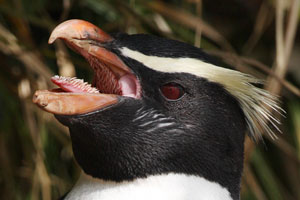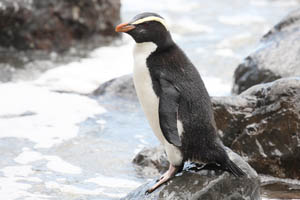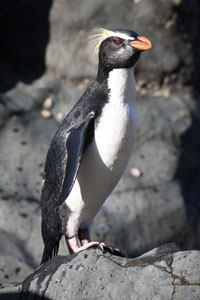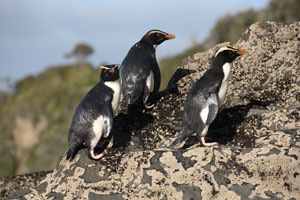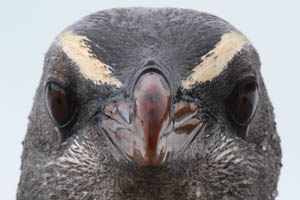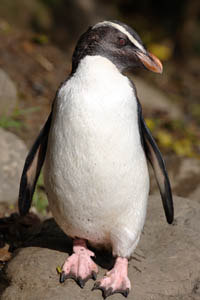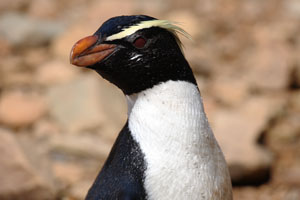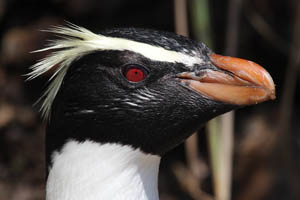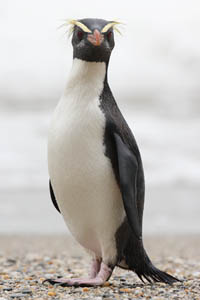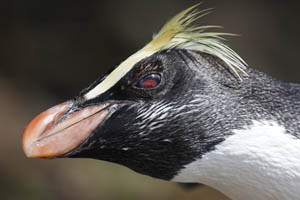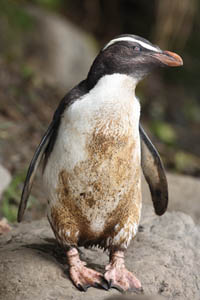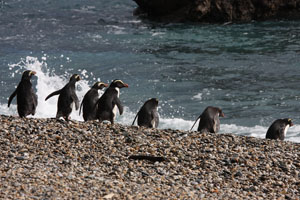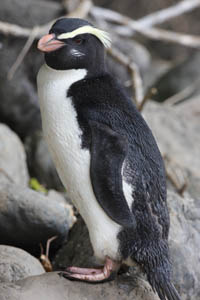Nest & Partner Selection:
Fiordland Crested Penguin nesting sites are in coastal temperate rainforests, mostly along the W coast of New Zealand. The nests may be solitary or in small colonies and are usually found in hollows under trees or rocky overhangs or in other small cavities. Those birds nesting more in the open at least tend to nest adjacent to logs or boulders. Nesting on top of sloping trunks has also been observed, and in one case, a nest was observed in a depression in the trunk of a Rata tree, about 10 m above the ground (Warham 1974. Ibis 116(1), p.1-27). Nests are usually lined with sticks and small amounts of other plant material which is largely collected by the male. Where the ground is soft, a small hollow may be excavated with the feet or with the belly by rotation on the nest site.
 |
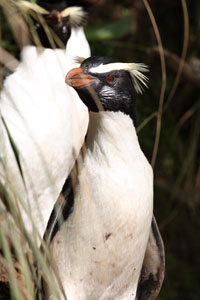 |
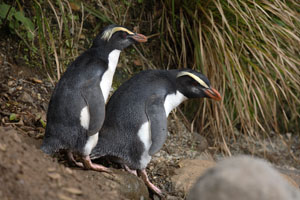 |
|
|
Penguins emerging from forest nesting area
|
|
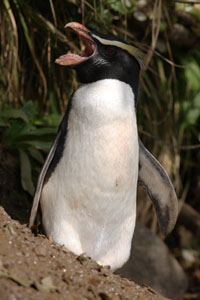 |
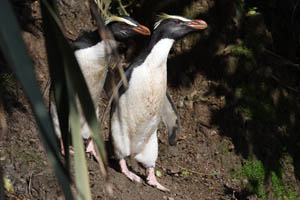 |
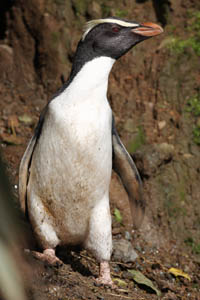 |
|
Penguin calling
|
Penguins emerging from forest nesting area
|
Penguin assessing situation
|
During the breeding season, all land-based activity is focused around the nest, even prior to egg laying. Fiordland Crested Penguins breed annually. Studies at Open Bay Island from 1988-1995 revealed that fidelity to both nests and partners is relatively high (Cassady St Clair et al.,1999. Marine Ornithol. 27, p.37-41). Mean nest fidelity of 76 and 72% was observed in returning males and females, respectively. Mate fidelity was lower (64 and 62%, respectively). When both members of a breeding pair returned in a subsequent year, 33% of females sought a new mate (i.e. 2 females and one male were observed at a nest) but only 13% of males. Previous breeding failure correlated with higher "divorce" rates. Those penguins that remained with previous partners had significantly higher breeding success than those with new partners. The correlation was even stronger for birds returning to their previous nest. When nest sites are moved, new sites are usually selected in the vicinity, with an average distance of only 8 m from the original nest site (Warham 1974. Ibis 116(1), p.1-27).
The birds appear to be largely socially and sexually monogamous as most chicks can be genetically attributed to the parents guarding their nest (McLean et al., 2000. NZ J. Zool. 27, p.311-316). Males return first (in June / July) to establish themselves at their nesting sites and are followed about a week later by the females. Fights over nest sites are common as are attacks by lone males on paired males, in an attempt to take over their mates. Courtship and establishment / reestablishment of a pair bond involves frequent vertical head waving and trumpeting displays. During or after establishment of the pair bond, egg development must commence in the female. Egg yolk formation takes about 16 days for both 1st and 2nd eggs and laying takes place about 7 days after yolk completion (Grau 1982. Condor 84, p.172-177). Fertilization is considered to occur 3-6 days before laying and is achieved by repeated copulation over a period of at least several days. During this whole period the birds remain on land and lose about 20% body weight.
Laying and Incubation:
A clutch of two eggs is usually laid from the end of July to mid-August, with laying generally synchronized in colonies and most clutches arriving over a period of 10 days. Between 10 and 20% of nests only contain single egg clutches. Since the first yolk starts to grow several days before the second, the first (smaller) egg precedes the other by about 4.3 days on average. The eggs of Eudyptid penguins differ significantly in size, with a small first egg being followed by a second large one which is about 19% more voluminous and 18% heavier in the Fiordland Penguin (Cassady St Clair 1992. Behav. Ecol. Sociobiol. 31, p.409-416). Large eggs are on average 7.1 cm long, 5.5 wide, and weigh 120 g shortly after laying. The shell accounts for 12.6% of mass, the yolk for 25% and the albumen for the remainder (Warham 1974. Ibis 116(1), p.1-27).
Incubation duties are shared. Initially, both birds appear to alternate duties for a period of 5-10 days. Then a first long shift is taken over by the male, whilst the female forages. The female then returns and takes over the 2nd long incubation shift as the male forages. Both of these long shifts last about 13 days. Several days before hatching, the male takes over again, and he remains in charge of incubation for the period covering hatching and beyond. Hatching occurs after 31-36 days. At this point, only the male or both birds may be at the nest site.
As in other Eudyptid penguins, the second egg tends to hatch first. The first egg may or may not hatch, yet since the other chick is older and generally only the larger chick is fed, the smaller chick will not tend to survive. This is a form of brood-reduction.
Brood Reduction Mechanism:
As in other crested penguins, Fiordland Penguins display a brood reduction mechanism, meaning that they only rarely raise 2 chicks. The mechanism is similar to that observed in the related Snares and Rockhopper Penguins. Macaroni, Royal and Erect-Crested Penguins display an even more extreme form of brood reduction. The reader is referred to the respective sections on these penguins for more detail.
In Fiordland Crested Penguins, during exceptionally good breeding seasons such as 1995 (with apparently copious food resources), about 12% of breeding pairs have been reported to raise 2 chicks (McLean, 2000. Notornis 47(1), p.57-60). This probably represents the highest success rate in raising two chicks in Eudyptid penguins, and is not surprising given that egg dimorphism is least extreme in Fiordland Crested Penguins.
The reasons for earlier hatching of the second egg have been studied in detail (Cassady St Clair 1992. Behav. Ecol. Sociobiol. 31, p.409-416). It has been observed that until laying of the second egg, non-incubating postures (i.e. bird off nest or standing on nest) are adopted nearly 50% of the time, compared to 5% of the time when both eggs were present. Further, the brood patch only started to develop (defeather and vascularize) after laying of the first egg. These observations account for the fact that the mean egg temperature of the first egg remained below 25'C until after arrival of the second. After arrival of the second egg, temperatures increased and averaged 33.7'C, at which they remained for the duration of the incubation period. It had been previously suggested that the common anterior positioning of the first egg in the nest could result in lower temperature, yet whilst egg temperature fluctuated more in the smaller egg, average temperatures of each egg in a two-egg nest were comparable in this study (the first egg was slightly colder but not at a statistically significant level). There is however data suggesting significant average temperature differences in Rockhopper Penguins which have a similar level of dimorphism. The higher temperature fluctuation suffered by the smaller egg may be due to incubation position or its lower heat capacity and this may retard development. The incubation position seems to be an inadequate explanation for the reversed hatching asynchrony based on this study, since in about 40% of nests the smaller egg did not preferentially occupy the anterior position. In these nests one would thus expect the smaller egg to hatch earlier if incubation position was crucial. This was however not generally the case. On average, first (A) eggs hatched 37.1 days after laying, but second (B) eggs after about 32.1 days. First eggs thus hatched on average 0.63 days earlier. Other factors may play a role in causing the slower development of the (A) egg. For example, the second eggs contain more albumen which may promote more rapid embryo growth. Further, recent studies on the Snares Penguin suggest that egg shell permeability may be a crucial factor.
Due to egg loss or failure of (usually) the first egg to hatch, hatching of both eggs occurs in only about half of nests. First egg loss is frequent, and possibly facilitated by the non-incubating stances common prior to laying of the second egg and the more frequent location in the exposed anterior position thereafter. Most loss of first eggs occurred before laying of the second egg, with several being lost shortly after arrival of the second egg.
If both eggs hatch, the larger chick is almost exclusively fed. The smaller first egg-derived chick will generally only survive if the other egg fails to hatch or if the other chick dies, except in years with exceptional food resources. If the larger chick dies, parents will switch to feeding the small (reserve) chick.
Brood / Guard Phase:
For the first days after hatching, chicks sit on the males feet in contact with the brood patch. Once the chick(s) gain in size they rest against the parent. The male is responsible for guarding the chick, whilst the female is solely responsible for foraging. The chicks from B eggs weigh about 80 g after hatching, with those from A eggs only weighing about 65 g. Growth of (single) chicks is generally about linear, with an initial mass increase of about 50 g per day. If two chicks survive, one is usually significantly heavier (having an almost normal mass). The smaller chick generally catches up in weight as it gets older. The chicks hatch with a thin protoptile down allowing efficient transfer of heat from the parents brood patch. The eyes open after about 5 days and the mesoptile down starts to develop after about 12 days. Thermoemancipation is presumably reached within about 18 days as in other Eudyptid penguins.
Only when the female returns to the nest to feed the chick (usually in late afternoon or evening), will the male briefly leave it, possibly wandering a few meters to collect nest material. Both birds perform a greeting ceremony upon arrival of the female. This involves mutual head-swinging and trumpeting. Chicks are usually fed almost once per day. Towards the end of the guard period, the chick may start to wander around in the vicinity of the nest, returning at signs of danger and during the night.
Creche:
After about 3-4 weeks the chicks can be left on their own as both parents forage. If sufficient nests are present in the area, chicks may form small creches. As the chicks get larger, the creches start to dissolve and the chicks may wander around on their own, only creching again if sensing danger. The chicks gradually develop their juvenile down, which can be distinguished from an adult down by its blueish tinge and shorter crest. A detailed description is provided by Warham (Ibis 116(1), p.1-27, 1974).
After about 60 days of near-linear growth, the chicks mass peaks at a mean of about 3 kg and a drop of more than 500 g may be observed thereafter before fledging. The feet develop fastest and reach 90% of adult size by the time of fledging. Flipper growth tails off after about 35 days, whilst bill development is much slower and continues after fledging.
The adults, especially the male, recover some of their weight loss during this period. The male feeds the chick less at the beginning of the creche phase, as its condition is poor after the long guard phase during which it had to fast.
Acoustic Parent-Chick Recognition:
Adult-chick recognition in penguins is largely considered to be acoustic. Upon return to the nest, adults call and display, usually performing bowing, followed by forward and vertical trumpeting. The chick normally runs from nearby cover or from a creche towards the adult whilst itself uttering short cries. It then pecks at the parent, stimulating it to regurgitate food. About 6-8 feedings are provided per adult return (Warham 1974. Ibis 116(1), p.1-27). Creche phase chicks preferentially respond to parental calls and parents rarely feed the wrong chicks (Studholme 1994. N. Z. Nat. Sci. 21, p.27-36). Adult call analysis using sonograms showed that calls were distinctive, and chicks calls could start to be distinguished from each other at an age of 2 weeks. Nevertheless, playback experiments even at 5 weeks of age were unable to elicit recognition, suggesting that visual cues may be very important in this species of penguin. However, it is also possible that there was some deficiency in the playback protocol, since all other Crested Penguins studied show acoustic recognition.
Hence, it is important to consider the findings in the other Eudyptid penguins. For example, adult Macaroni Penguins make about 1.75 sec long calls, made up of a long first component (syllable), followed by a second similar-lengthed part consisting of 5-30 (av. 12.84) brief syllables (Searby et al., 2004. Animal Behav. 67, p.615-625) of which the 1st are repetitive short syllables, with the final 2 syllables being marginally longer. The tempo of the syllables, together with their harmonic content, make the signal distinctive, meaning that Macaroni Penguins have a double vocal signature. The call is similar to that of the Rockhopper Penguin (0.45 sec), yet the individual syllables are more distinctive in the Macaroni penguin (Searby and Jouventin 2005. J. Avian Biol. 36, p.449-460). Both Rockhopper and Macaroni calls, and probably Snares Penguin calls, are less complex than the double vocal signature of Aptenodytes penguins (e.g. Emperor), but more complex than the purely harmonic system in Pygoscelis penguins (e.g. Adelie, Gentoo).
Fledging:
Chicks eventually leave for sea at an age of about 75 days, usually in late November. The departure of the chicks is gradual and they do not appear to be accompanied by other chicks or adults. Fiordland Penguins usually only start to breed at an age of 4 years. Fledged chicks are recognizable by their greyish-blue plumage.
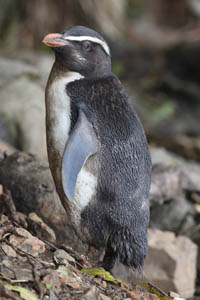 |
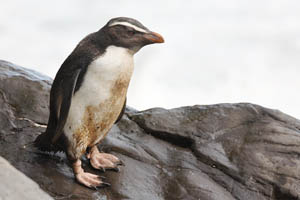 |
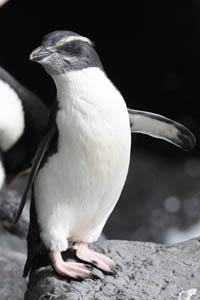 |
|
Yearling (?)
|
Yearling (?)
|
Fledgling
|
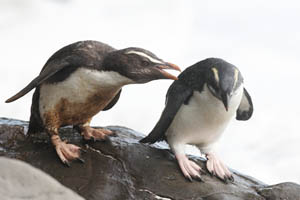 |
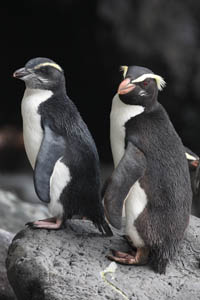 |
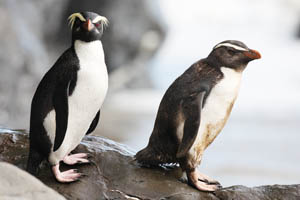 |
|
Yearling harassing fledgling
|
Fledgling with adult
|
Adult and yearling (?)
|
Moult:
After their chicks have fledged, breeding adults depart to sea for about 60-80 days in order to forage and increase mass in advance of the energetically demanding moult. A mass of about 5 kg is often reached. Moulting breeders often moult at or near their nest sites together with their partners. After several days, the old plumage starts to be shed and by about 3 weeks this process is complete. The birds usually wait another week for the new plumage to develop before departing to sea for the long summer foraging period. Nearly half of the body weight is lost during the moulting process. The moult is usually concluded in early March, and birds remain largely at sea thereafter, until returning for the next breeding season.
Juvenile birds also return to land after the summer foraging season, although the timing of their arrival may not coincide with that of breeding birds. These yearlings can still be distinguished from the adult birds by a number of characteristics including crest, bill and eye colour or size (Warham 1974. Ibis 116(1), p.1-27).
|
